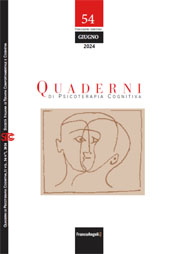Ruolo della TCC e linee guida NICE e CANMAT per il trattamento della depressione negli adulti
P. 94-109
Il presente lavoro delinea le indicazioni di buona pratica clinica per il trattamento della depressione sulla base dell'ultimo aggiornamento delle linee guida del National Institute for Health and Care Excellence (NICE) e del Canadian Network for Mood and Anxiety Treatments (CANMAT), documenti considerati un punto di riferimento in tutto il mondo. Pertanto, verranno utilizzati per tracciare indicazioni per il contesto Italiano. In particolare, ci si concentrerà sul ruolo che ha la terapia cognitivo-comportamentale (TCC), nelle sue varie forme, nel trattamento della depressione a diversi livelli di severità, rispetto ad altri tipi di trattamento e in diverse fasi del trattamento. Innanzitutto, si definirà il quadro depressivo, i diversi livelli di severità, e le varie forme di TCC considerate.
Seguiranno i metodi attraverso i quali si suggerisce di scegliere un determinato intervento, non necessariamente psicologico, a seconda della severità della depressione o di altri fattori come il rapporto costi-benefici per il sistema sanitario o le preferenze del paziente. Di seguito, si illustreranno i dati scientifici sull'efficacia degli interventi cognitivo-comportamentali, rispetto agli altri interventi, e le raccomandazioni per ogni grado di severità o fase di trattamento. Si concluderà osservando che l'efficacia della TCC è altamente dimostrata per la depressione e risulta spesso tra i primi interventi suggeriti per questo quadro. Più il quadro è lieve più la TCC è consigliata; più il quadro si aggrava, o è in fase acuta, più si suggerisce di abbinarla ad altri trattamenti. Infine, si rifletterà su spunti per adattare metodologie e procedure al contesto Italiano. [Testo dell'editore]
This paper outlines the indications of good clinical practice for the treatment of depression on the basis of the latest update of the guidelines of the National Institute for Health and Care Excellence (NICE) and of the Canadian Network for Mood and Anxiety Treatments (CANMAT), documents that are a benchmark worldwide. Therefore, they will be used to draw indications for the Italian context. We will focus on the role played by cognitive-behavioural therapy (CBT), in its various forms, in the treatment of depression at different levels of severity, compared to other treatments and in different phases of treatment. We will define depression, its different levels of severity, and the various forms of CBT considered. We will then describe the methods used to select a particular intervention, not necessarily psychological, depending on the severity of depression or other factors such as cost-benefit to the health system or patient preference.
Below we will describe the scientific data on the effectiveness of cognitivebehavioural interventions compared with others, and recommendations for each level of severity or phase of treatment. We will conclude that the effectiveness of CBT for depression is well established and is often one of the first interventions suggested for this framework. The milder the framework, the more CBT is recommended; the more the framework worsens, or it is in the acute phase, the more it is suggested to be combined with other treatments. Finally, we will reflect on ideas for adapting methods and procedures to the Italian context. [Publisher's text]
Fa parte di
Quaderni di Psicoterapia Cognitiva : 54, 1, 2024-
Articoli dello stesso fascicolo (disponibili singolarmente)
-
Informazioni
Codice DOI: 10.3280/qpc54-2024oa18658
ISSN: 2281-6046
MATERIE
PAROLE CHIAVE
- Good clinical practice, Cognitive psychotherapy, Depression
- Buona pratica clinica, Psicoterapia cognitiva, Depressione


